Botanical Nomenclature
Before the work of Carolus Linnaeus (1707–1778), the botanist who established the binomial system of plant nomenclature, a plant sometimes had a name that consisted of many descriptive words. Linnaeus helped to standardize botanical nomenclature by establishing a genus and species name for each plant, followed by its designator. A clinical report involving a plant must always include the plant’s botanical (binomial) name, which consists of both the genus and the species, for example, Duranta repens. By convention, both are italicized or underlined. Duranta is the name of the genus and the first letter is always capitalized. A genus (the plural of which is genera) may be composed of a single species or several hundred. The second part of the binomial, in this case repens, is the particular species within the genus, and it is always in lowercase letters. It is important to include the name of the person (often abbreviated) who named the particular species, as part of the scientific name, to minimize confusion between similar or related plant species. For example, in the case above, the complete name, which would allow the most precise identification, is Duranta repens L.; L. is the accepted abbreviation for Carolus Linnaeus.
Over time, as botanists continue to revise the classification systems of their specific plant families or groups to reflect additional knowledge and a more natural, evolutionarily based system, plants are periodically moved into different genera or sometimes different families. A species may be split into several species or varieties, or lumped together with plants of other species to comprise a single species, all based on the expertise of the taxonomist utilizing characteristics from other specialties ranging from gross morphology to molecular biology. One shortcoming of this fluid system is that scientists can have differing opinions as to how to classify a specific plant. To limit confusion with regard to nomenclature, when previously employed names are changed as part of a more recent taxonomic study, they become recognized as synonyms. In this book, the most common current synonyms are included in parentheses with an equal sign, for example, Duranta repens L. (= D. plumferi Jacq.). Some species are divided further into subspecies (ssp.), varieties (var.), cultivated varieties (cultivars (cv.)), and forms (fo.); for example, Philodendron scandens C. Koch & H. Sello ssp. oxycardium (Schott) Bunt. In this instance, the plant was first named Philodendron oxycardium by Heinrich Schott, but was reevaluated and then transferred to become a subspecies of Philodendron scandens by George Bunting. Hybrid names are indicated by an × (multiplication symbol), as in Brugmansia × candida. Horticultural names are not italicized but are capitalized and set in single quotation marks, for example, Ilex glabra cv. ‘Compacta.’ A printed work can never be fully up to date from a taxonomic standpoint because taxonomists are constantly refining the classification systems of the groups on which they work. At the same time, there may be a significant volume of medical literature based on an “older” name and not linked to the updated name, and thus, for most efficient and rapid use of the information in this volume, some of the older names are retained.
Associations of like genera are placed in a family. The family name is not italicized, but the initial letter is always capitalized. Botanists have changed the status of some families to reflect a more natural evolutionary lineage, either by incorporating them into other families and dropping their original designation or by creating entirely new families. Since the publication of the original edition of this Handbook, family names for some of the genera have been changed, but in this new edition the older name has been maintained to facilitate rapid consultation of the toxicological literature, and the new name is added in parentheses, for example, Umbelliferae (= Apiaceae). Updated family names for plants can be found on the Angiosperm Phylogeny Website which is continually updated with new information (http://www.mobot.org/MOBOT/research/APweb/). We also head many of the poisoning syndromes in Section 5 with the name of the genus followed by the word “species” (spp.) to indicate that there are several to many species in this genus having toxic properties.
Examples of Plants Producing Systemic Poisoning in Humans Arranged by Family and Genus
Amaryllidaceae |
Amaryllis |
Clivia |
Crinum |
Galanthus |
Hippeastrum |
Hymenocallis |
Lycoris |
Narcissus |
Zephyranthes |
Anacardiaceae |
Schinus |
Apocynaceae |
Acokanthera |
Adenium |
Allamanda |
Nerium |
Pentalinon |
Thevetia |
Aquifoliaceae |
Ilex |
Araceae |
Alocasia |
Anthurium |
Arisaema |
Arum |
Caladium |
Calla |
Colocasia |
Dieffenbachia |
Epipremnum |
Monstera |
Philodendron |
Raphidophora |
Spathiphyllum |
Symplocarpus |
Xanthosoma |
Zantedeschia |
Araliaceae |
Hedera |
Asclepiadaceae |
Calotropis |
Cryptostegia |
Berberidaceae |
Caulophyllum |
Podophyllum |
Boraginaceae |
Echium |
Heliotropium |
Calycanthaceae |
Calycanthus |
Campanulaceae |
Hippobroma |
Lobelia |
Caprifoliaceae |
Lonicera |
Sambucus |
Symphoricarpos |
Celastraceae |
Celastrus |
Euonymus |
Compositae |
Senecio |
Coriariaceae |
Coriaria |
Cornaceae |
Aucuba |
Corynocarpaceae |
Corynocarpus |
Cucurbitaceae |
Momordica |
Cycadaceae |
Cycas |
Ericaceae |
Kalmia |
Leucothoe |
Lyonia |
Pernettya |
Pieris |
Rhododendron |
Euphorbiaceae |
Aleurites |
Euphorbia |
Hippomane |
Hura |
Jatropha |
Manihot |
Pedilanthus |
Ricinus |
Ginkgoaceae |
Ginkgo |
Guttiferae |
Calophyllum |
Clusia |
Hippocastanaceae |
Aesculus |
Iridaceae |
Iris |
Leguminosae |
Abrus |
Baptisia |
Caesalpinia |
Cassia |
Crotalaria |
Gymnocladus |
Laburnum |
Leucaena |
Pachyrhizus |
Robinia |
Sesbania |
Sophora |
Wisteria |
Liliaceae |
Allium |
Aloe |
Bulbocodium |
Colchicum |
Convallaria |
Gloriosa |
Ornithogalum |
Schoenocaulon |
Scilla |
Urginea |
Veratrum |
Zigadenus |
Loganiaceae |
Gelsemium |
Spigelia |
Strychnos |
Loranthaceae |
Phoradendron |
Viscum |
Meliaceae |
Melia |
Swietenia |
Menispermaceae |
Menispermum |
Myoporaceae |
Myoporum |
Oleaceae |
Ligustrum |
Palmae |
Caryota |
Papaveraceae |
Chelidonium |
Phytolaccaceae |
Phytolacca |
Rivina |
Polygonaceae |
Rheum |
Ranunculaceae |
Aconitum |
Actaea |
Adonis |
Anemone |
Caltha |
Clematis |
Helleborus |
Pulsatilla |
Ranunculus |
Rhamnaceae |
Karwinskia |
Rhamnus |
Rosaceae |
Eriobotrya |
Malus |
Prunus |
Rhodotypos |
Rutaceae |
Poncirus |
Sapindaceae |
Blighia |
Sapindus |
Saxifragaceae |
Hydrangea |
Scrophulariaceae |
Digitalis |
Solanaceae |
Atropa |
Brugmansia |
Capsicum |
Cestrum |
Datura |
Hyoscyamus |
Lycium |
Nicotiana |
Physalis |
Solandra |
Solanum |
Taxaceae |
Taxus |
Thymelaeaceae |
Daphne |
Dirca |
Umbelliferae |
Aethusa |
Cicuta |
Conium |
Oenanthe |
Verbenaceae |
Duranta |
Lantana |
Zamiaceae |
Zamia |
There are no rules for establishing common names of plants. Common names can be highly misleading and may erroneously suggest toxicity or the lack of toxicity. For example, a plant known as a “pepper” plant could be the sweet pepper commonly eaten as a vegetable (Capsicum annuum L. var. annuum); or one of the extremely hot, virtually “inedible” peppers (particularly when eaten in quantity and certainly depending on the person’s palate) used as a decorative houseplant in that same species but containing significant quantities of capsaicin; or the spice plant from which we derive black pepper (Piper nigrum L.); or the pepper bush (Leucothoe species) containing grayanotoxins; or the pepper tree (Schinus molle L.) with triterpene-containing berries; or any number of other species with “pepper” as part of its common name. Another problem associated with common names is that they can sometimes lead to the assumption that plants are related—either botanically or toxicologically. For example the “hellebore,” Helleborus niger L., is in the family Ranunculaceae, but it bears no relationship to the “false hellebore,” Veratrum viride Aiton, a member of the family Liliaceae; the former species contains toxic glycosides and saponins and the latter contains toxic alkaloids. The botanical (binomial) nomenclature is essential for ensuring proper plant identification.
Common names are included throughout this book only to facilitate in the identification of a particular plant in question. Many common names are no longer in use and others have been developed, but there is no way to verify contemporary use except by interviewing the inhabitants of a region and recording their responses. Thus, for a compilation of common names in this text we depended on the literature. The common names of native species from the United States and Canada are taken from Kartesz and Kartesz (1980). Names for West Indian species and Guam were selected from the floras listed in the references. Common names for cultivated plants were taken primarily from Hortus Third. In addition to floras, Hawaiian names are from Neal (1965), Cuban names from Roig y Mesa (1953), and Mexican names from Aguilar and Zolla (1982). Many less-common, older names for plants in the United States were selected from Clute (1940). When bolded, the common name connotes the most widely employed name in contemporary use in the United States.
Care must be exercised when evaluating poisonous plant literature. In some instances, information on the toxicity of plants in grazing animals is extrapolated to predict that which may occur in humans. Unsubstantiated plant lore has passed through generations of textbooks; we have attempted to remove as much lore as possible. Even evaluations based on human case reports, which act as the foundation for this book, may be flawed by erroneous identification of the plants or inappropriate attribution of the clinical effects to the plant.
Glossary of Botanical Terms
This list of botanical and horticultural terms is provided to aid in understanding the plant descriptions found in the text. The terms have mostly been taken from two primary references, Manual of Vascular Plants of Northeastern United States and Adjacent Canada, Second Edition (Henry A. Gleason and Arthur Cronquist, 1991) and Hortus Third: A Concise Dictionary of Plants Cultivated in the United States and Canada (Liberty Hyde Bailey and Ethel Zoe Bailey, Revised and Expanded by The Staff of the Liberty Hyde Bailey Hortorium, 1976). Some definitions have been modified from the original for ease of use and understanding by the nonbotanist, and the reader is urged to consult a botanical textbook if greater detail is required. The botanical illustrations are by Bobbi Angell.

Yearly; a plant that germinates, flowers, and sets seed during a single growing season.
The portion of the stamen of a flower that contains the pollen, usually having two connected pollen sacs.
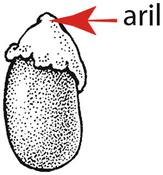
Outer surface of the trunk of a tree or woody shrub.
Bearing a tuft or ring of rather long hairs.
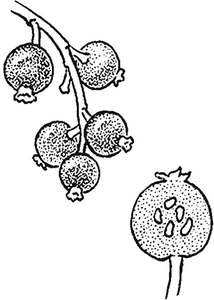
Living 2 years only and blooming the second year.
The expanded, terminal portion of a flat organ such as a leaf, petal, or sepal, in contrast to the narrowed basal portion.
Hard surface as in a bone.
Any more or less reduced or modified leaf associated with a flower or an inflorescence that is not part of the flower itself.
Diminutive of bulb; one of the small new bulbs arising around the parent bulb; a bulblike structure produced by some plants in the axils of leaves or in place of flowers.

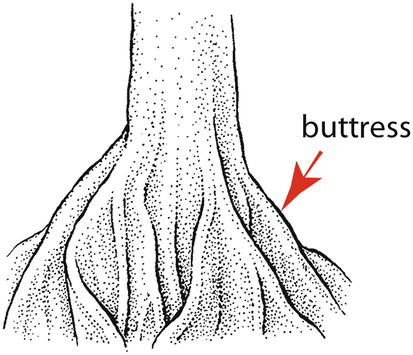
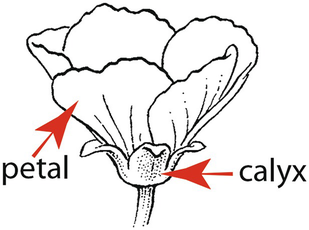
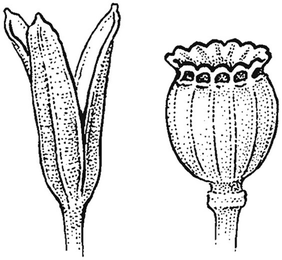
The fertile leaf of an angiosperm that bears the ovules. The pistil (female part of the flower) is made up of one or more carpels, where the seeds normally are found.
Growing more or less erect without fully supporting its own weight, instead leaning, scrambling, twining, or attaching onto some other structure such as a tree or wall.
Rough, as in the texture of a leaf.
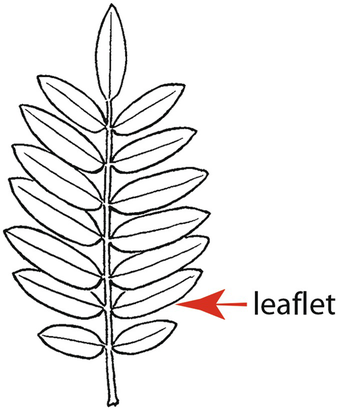
A cluster of sporophylls or ovuliferous scales on an axis; a strobilus, as in pine or cycad cones.
All the petals of a flower collectively.
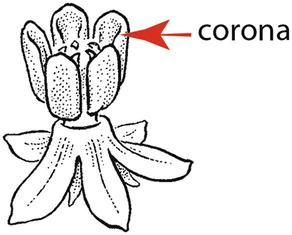
Growing along (or beneath) the surface of the ground and rooting at intervals, usually at the nodes.
A horticultural variety originating from a cultivated plant, possessing interesting or important characters such as color, smell, taste, or disease resistance that make it worthy of distinction through naming.
Small pieces of stems or roots that can be put in soil to develop into a complete plant.
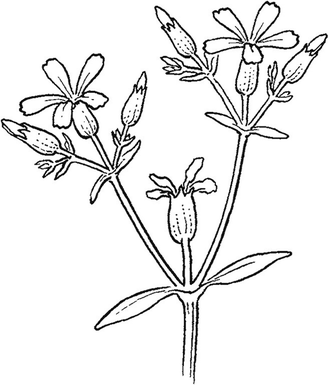
Falling after completion of the normal function. A deciduous tree is one that normally loses its leaves at the approach of winter or the dormant season.
Opening when mature, exposing or releasing the contents, as in a fruit releasing it seeds.
One of the two major divisions of the angiosperms (a group characterized by having ovules borne in ovaries) bearing two (or rarely more) cotyledons or seed leaves, comprising most of the familiar seed plants.
Cut into distinct parts, as a leaf that is cut to the midrib or the base.
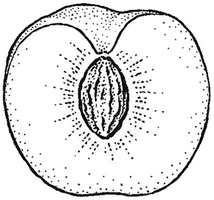
Elliptical in long section and circular in cross section (applied only to three-dimensional bodies).

Upright.
As in an introduced plant species that has escaped from cultivation into the wild.
Remaining green throughout the winter, as in a tree that keeps its leaves throughout the year.
Feather shaped in outline, as in leaves.
Referring to flowers that are pistillate, having pistils but no stamens.
The stalk of a stamen, that is, the part that supports the anther.
Leaves with small serrations on the edges.
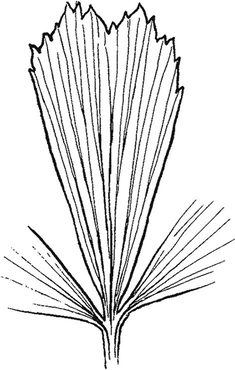
Thick and juicy; succulent.
Greatly reduced leaf associated with a flower, usually at its base.
Branches or axes on which flowers are formed.
An axis bearing one or more pistils or one or more stamens or both.
A ripened ovary along with any other structures that may ripen with it and form a unit with it.
Fleshy material inside of a fruit, often the part that is eaten by humans or animals.
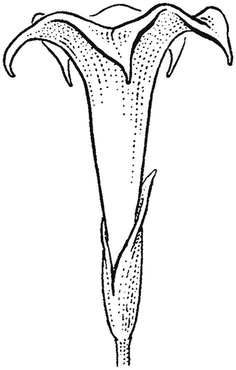
Having longitudinal channels or grooves along the stem.
Covered with a fine, waxy, removable powder that imparts a whitish or bluish cast to the surface, as in a prune or a cabbage leaf.
More or less spherical.
Shiny.
A cluster of flowers crowded closely together at the tip of a floral stem.
A plant, either annual, biennial, or perennial, with the stems dying back to the ground at the end of the growing season, and without woody stems.
Adjectival form of herb; also, leaflike in color or texture, or not woody.
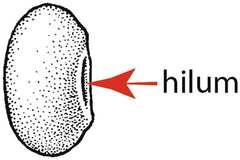
As in cultivars.
A plant that results from a cross between two parent species that are genetically different.
Remaining closed at maturity.
A flower cluster of a plant; the arrangement of the flowers on the axis.
A younger form or shape of the leaves of a plant, which change when the plant reaches maturity.
As in the shape of leaves with many tears or cuts.
As in leaves that are several times longer than broad and widest below the middle, tapering with convex sides upward to the tip.
A colorless, white, yellow, or reddish liquid, produced by some plants, characterized by the presence of colloidal particles of terpenes dispersed in water.
An ultimate unit of a compound leaf. (see Compound leaf).
Thick and leatherlike in texture, as in a leaf.
A projecting segment of an organ, too large to be called a tooth, but with the adjoining sinuses usually extending less than halfway to the base or midline.
A fruit that has ripened; often a different color from when it was young.
The main rib or longitudinal vein (an externally visible vascular bundle) of a leaf or leaflet.
White-colored sap of a plant.
One of two major divisions of the angiosperms (a group of plants characterized by having ovules borne in ovaries), bearing only one cotyledon or seed leaf, for example, the grasses, lilies, bromeliads, orchids, and palms.
Having its origins in a particular geographic area, as in a plant native to the Western United States.
Thoroughly established in a particular geographic region, but originally coming from another geographic area.
Pertaining to the Western Hemisphere, particularly the Americas, as in a plant native to that region.
A relatively large, dry, indehiscent fruit with a hard wall, usually containing only one seed.

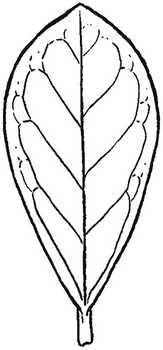
Pertaining to Europe, Asia, and Africa, as in a plant native to that region.
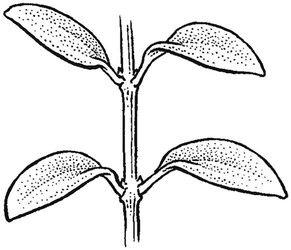
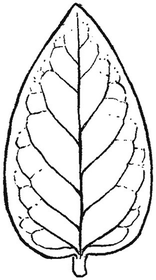
A young or undeveloped seed.
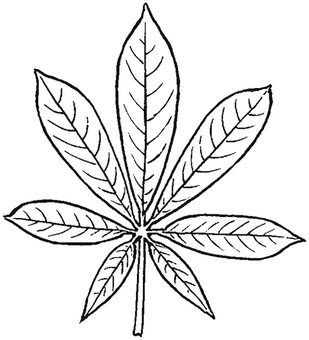
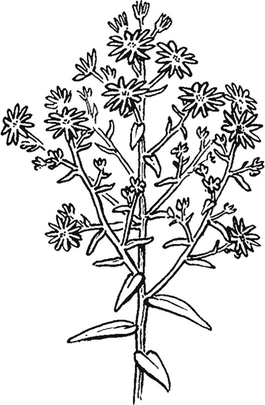
A branching indeterminate inflorescence, usually broadest near the base and tapering upwards.
Found throughout the tropical regions.
Borne on a pedicel (stalk of a single flower in an inflorescence).
Hanging, as in pendant racemes of flowers.
A plant living more than 2 years.
A member of the inner set of floral leaves, usually colored or white and serving to attract pollinators.
The female organ of a flower, ordinarily differentiated into an ovary, style, and stigma.
Hardened covering enclosing seed or seeds in a fruit, as in a peach.
When young, as in a leaf, folded several times along the length.
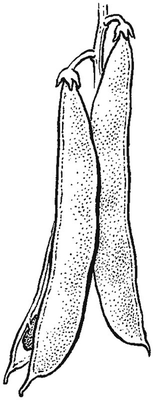

As in multiplying a plant through making cuttings and planting them.
Bearing hairs (trichomes) of any sort.
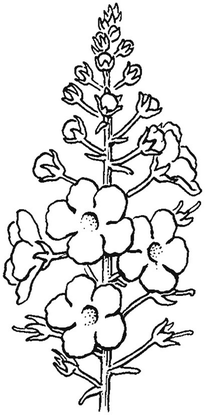
Flower petals that are curved downward or backward.
Containing resin.
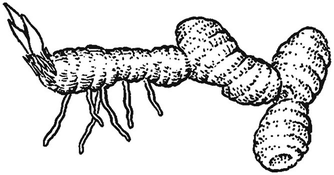
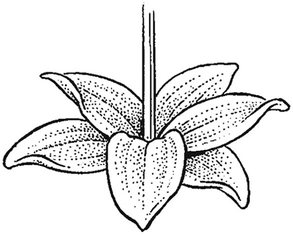
A long, slender, prostrate stem rooting at the nodes and tip.
Liquid contained within the stem.
Any small, thin, or flat structure.
Covered with scales or bracts.
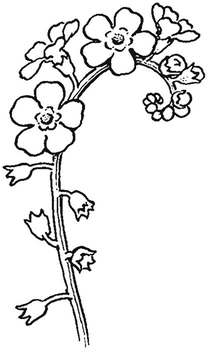
Outside coating of a seed.
As in a fruit or pod containing seeds.
One of the outermost set of floral leaves. (see Calyx).
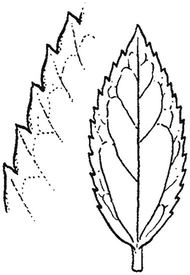
Saw toothed, with teeth pointing forward toward the tip of the leaf.
Conspicuous and ornamental.
A woody plant that remains low and produces shoots or trunks from its base.
A covering of fine, soft hairs.
A leaf with the blade all in one piece (although it may be deeply cleft), not compound.
The cleft between two lobes or segments of a leaf.
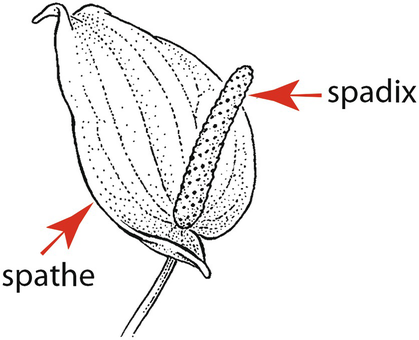
A large, usually solitary bract subtending and often enclosing an inflorescence; the term is used only in the monocotyledons.
As in a leaf shaped like the head of a spear.
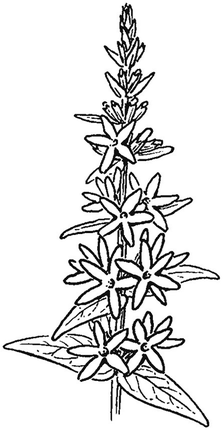
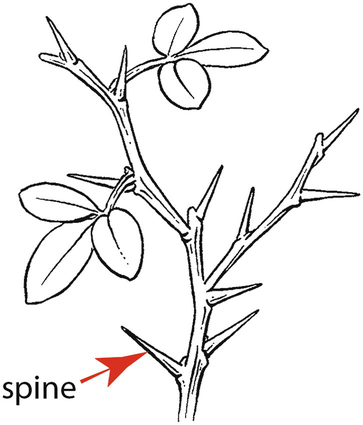
A modified leaf that bears or subtends the spore-bearing cases in certain plants such as ferns and cycads.
Clusters of flowers.
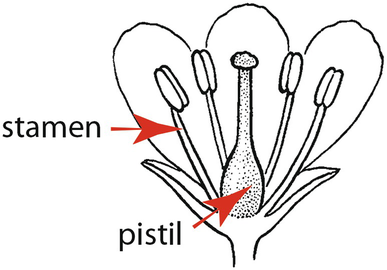
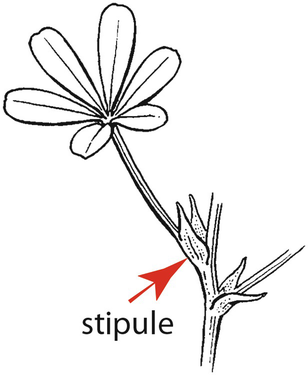
As in a long, narrow, thick leaf.
A cluster of sporophylls or ovule-bearing scales on an axis, such as in a cone.
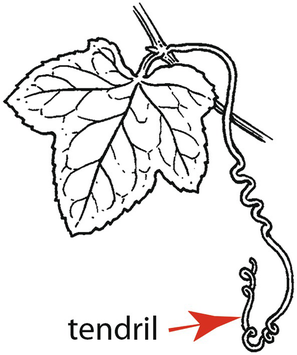
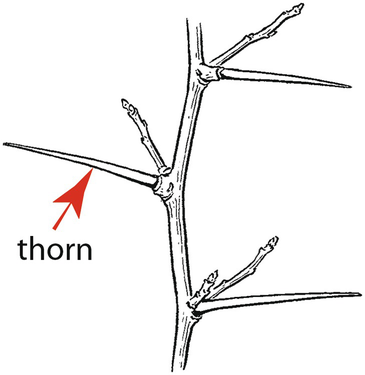
A stiff, woody, modified stem with a sharp point.
The opening or orifice of a fused corolla or calyx, or the somewhat expanded part between the proper tube and the limb; in grasses, the upper margins of the sheath.
Serration, as on the edge of a leaf (plural, teeth).
Thickened like a tuber, as in roots.
Differently colored areas, as in a leaf with streaks, marks, or patterns of various colors on its surface.
A subdivision of a species ranking lower than a subspecies.
With erect, straight, moderately firm hairs, such as on a stem or leaf.
Covered with wartlike structures.
A plant that aggressively colonizes disturbed habitats or places where it is not wanted.

Adams CD. Flowering plants of Jamaica. Mona, Jamaica: University of West Indies; 1972.
Aguilar Contreras A, Zolla C. Plantas Tóxicas de México. Mexico D.F: Subdirección General Médica, División de Información Ethnobotánica, Unidad de Investigación Biomédica en Medicina Tradicional y Herbolaria del Instituto Mexicano del Seguro Social; 1982.
Bailey LH, Bailey EZ. Liberty Hyde Bailey Hortorium Staff. Hortus Third. New York: Macmillan; 1976.
Barker HD, Dardeau WS. Flore d’Haïti. Port-au-Prince, Haiti: Publié sous la direction du Service technique du Département de l’agriculture et de l’enseignement professionnel; 1930.
Clute WN. American plant names. 3rd ed. Indianapolis: Willard N. Clute; 1940.
Correll DS, Correll HB. Flora of the Bahama Archipelago. Vaduz J. Cramer, Germany; 1982.
Gleason HA, Cronquist A. Manual of vascular plants of Northeastern United States and Adjacent Canada. 2nd ed. New York: The New York Botanical Garden; 2004.
Gooding EGB, Loveless AR, Proctor GR. Flora of Barbados. London: Her Majesty’s Stationery Office; 1965.
Howard RA, editor. Flora of the Lesser Antilles: Leeward and Windward Islands. Jamaica Plain: Arnold Arboretum, Harvard University; 1974.
Kartesz JT, Kartesz R. A synonymized checklist of the vascular flora of the United States, Canada, and Greenland. Chapel Hill: University of North Carolina Press; 1980.
Kuijt J. Monograph of Phoradendron (Viscaceae). In: Systematic botany monographs, vol. 66. Laramie: The American Society of Plant Taxonomists, University of Wyoming; 2003.
León Hermano (Sauget J). 1946. Flora de Cuba, vol. 1. Havana: Museum de Historia Natural del Collegio de La Salle; 1957.
León Hermano (Sauget J), Hermano Alain (Liogier H). Flora de Cuba, vols. 2–4. Havana: Museum de Historia Natural del Collegio de La Salle; 1951–1957.
Liogier AH. Flora de Cuba, vol. 5. Rio Piedras, Puerto Rico: Editorial Universitario, Universidad de Puerto Rico; 1962.
Liogier AH. Flora de Cuba, Supplemento. Caracas: Editorial Sucre; 1969.
Liogier AH. Diccionario Botánico de Nombres Vulgares de la Español. Santo Domingo: Jardín Botaníco Dr. Rafael Moscoso; 1974.
Liogier AH, Martorell LF. Flora of Puerto Rico and Adjacent Islands: a systematic synopsis. Rio Piedras, P.R.: Editorial de la Universidad de Puerto Rico; 1982.
Neal MC. In Gardens of Hawaii. Honolulu: Bishop Museum Press; 1965.
Roig y Mesa JT. Diccionario Botanico de Nombres Vulgares Cubanos. Bulletin 45. Havana: Ministry of Agriculture; 1953.
Scoggan HJ. Flora of Canada (4 vols). Ottawa: National Museum of Natural Sciences; 1978–1979.
Stone BC. The flora of Guam. Micronesica. 1970;6:1–659.
Tutin TG, Heywood VH, Burgess NA, Valentine DH, Walters SM, Webb DA. Flora Europaea (5 vols). New York: Cambridge University Press; 1964–1980.
Frohne DA. Colour atlas of poisonous plants: a handbook for pharmacists, doctors, toxicologists, and biologists. London: Wolfe; 1984.
Kingsbury JM. Poisonous plants of the United States and Canada. 3rd ed. Englewood Cliffs: Prentice Hall; 1964.
Kingsbury JM. Deadly harvest: a guide to common poisonous plants. New York: Holt, Rinehart & Winston; 1965.
Leopold WC. Poisonous plants of the United States. New York: Macmillan; 1951.